This being the first weekend of the state school summer holidays, today’s picture is Philipp Otto Runge’s sun-drenched portrayal of The Hulsenbeck Children at play. The painting was done in 1805-6 for the children’s father, the Hamburg merchant Friedrich August Hulsenbeck. History does not record the patron’s reaction to the work he had commissioned, but it is an unsettlingly intense creation and may have been more than he had bargained for. Runge captured the holiday mood of high summer but he also gave the rowdy brood of a German businessman the air of prophets or seers. Although they have the chubby faces of infants they stare glassily into space with a faraway, mystical gaze. Little August Hulsenbeck, in the centre of the painting, and his even littler baby brother, Friedrich, seated in a rustic baby carriage to the left, seem to stare right through us, as if penetrating to a higher truth. Their beatific but enigmatic expressions call to mind Ralph Waldo Emerson’s remark that the gaze of children “is as yet unconquered and when we look into their faces we are disconcerted”. Runge’s pictureis not just a portrait but a nervy and highly charged celebration of childhood itself, a condition which the artist idealised as a state of visionary innocence. “We must all become children again to reach perfection,” he wrote in one of his notebooks.
The belief that there is something special or sacred about childhood, to which Runge gave such eccentrically potent expression, is deeply rooted but of comparatively recent origin. In his pioneering study The Family, Sex and Marriage the historian Lawrence Stone identified “a remarkable change in child-rearing theory” which took place between 1660 and 1800. According to the traditionally stern Christian and Calvinist view which held sway at the start of this period, every child...


